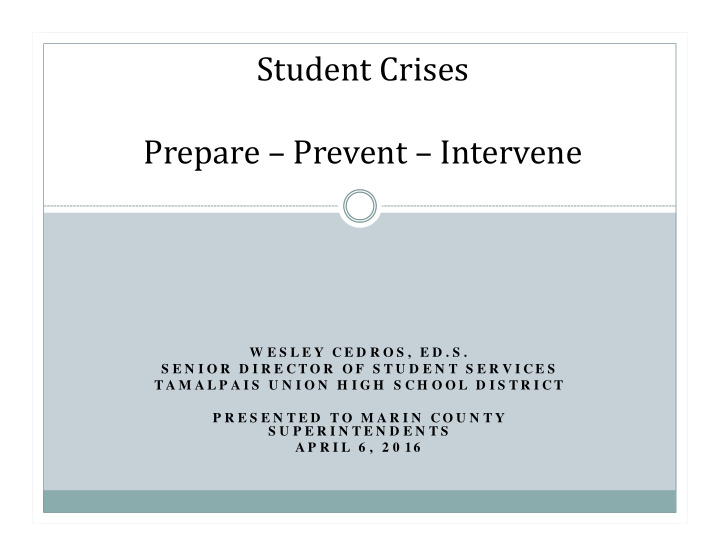



Student Crises Prepare – Prevent – Intervene W E S L E Y C E D R O S , E D . S . S E N I O R D I R E C T O R O F S T U D E N T S E R V I C E S T A M A L P A I S U N I O N H I G H S C H O O L D I S T R I C T P R E S E N T E D T O M A R I N C O U N T Y S U P E R I N T E N D E N T S A P R I L 6 , 2 0 1 6
“Nothing is more important than our students’ safety, and preparation is one of the first and more important steps a school can take in creating a more positive school climate.” Tom Torlakson CA State Superintendent of Public Instruction Letter to superintendents (2/24/2014 ) “It is imperative that we collaborate to adopt district policies and administrative regulations to address suicide prevention in our school districts.” Tom Torlakson CA State Superintendent of Public Instruction Letter to superintendents (7/21/2014 )
STUDENT CRISES Preparation Intervention Postvention (Response) Resources
PREPARATION o Policy & Practice o Monitor At‐Risk Students & Situations o Training & Staff Development o Crisis Response Team (CRT)
Policy & Practice Policies SB187 School Safety Plans SB634 School Safety Plans/ Safety Drills CA Ed Code §41533 (Jason Flatt Act) CA Ed Code §32280-32289 Local Board Policy Practices Update School Safety Plan Seek Input from Stakeholders, Law Enforcement, Community Partners Practice, Refine, Practice Again!
Identify & Monitor Identify and closely follow at-risk students Provide mental health and social support Work closely with parents/ guardians Identify and monitor other potentially dangerous situations Personnel disputes Bullying & Harassment Upset parents and/ or community members Gang activity Law enforcement concerns
Training & Education Training & education recommendations for school staff, students, parents/community School‐wide suicide prevention programs Sources of Strength, Signs of Suicide MH Awareness & Gatekeeper Training QPR, ASIST, More than Sad , Mental Health First Aid Create a safe and caring school climate Character education programs (e.g., 6 Pillars, Second Step) Robust anti‐bullying policy Restorative practices
Crisis Response Team Crisis response requires collaboration Set roles and responsibilities allow for smoother application of protocols in crisis Team members may vary by site – personalize to match available staff Although CRT most intimately involved, ALL school staff should know when/how/to whom to refer at‐risk students & understand a basic summary of intervention procedures
CRT Roles & Responsibilities All Members Respond to urgent situations when needed Call 911, if needed Inform Team Leader about at‐risk students/situations Provide first aid, when needed Clear area and ensure student safety Team Leader Coordinates annual training Mobilizes team members, as needed Coordinates team member assignments Liaison between principal and district office
CRT Roles & Responsibilities Principal/ Assistant Principal Liaison with police, fire or other authorized outside agency Brief district office administration Notifies family members of student crisis Modifies school schedule, if necessary Resumes normal schedule as soon as possible Secures campus Communicates with other school sites, as necessary Evaluates and revises school crisis response, as necessary
CRT Roles & Responsibilities School Psychologist/ Counselors Conducts student interviews, risk assessments Contacts community resources Contacts and works with parents Documents actions School Nurse or Health Technician Administers first aid, triage Locates emergency card for injured student(s) Campus Supervisor Coordinates immediate security and protection Roams campus to identify students in need
CRT Roles & Responsibilities School Secretary Maintains up-t0-date info for CRT Maintains communication for principal Responds to crisis-related inquiries (uses sample script) Teachers Take every warning sign seriously Ensure safety of students during and after emergency If in stay-put/ shelter-in-place situation – do not all0w students to enter or exit room Keep students informed as directed by principal Reassure students Focus discussion on reaction students are having and how to support each other Refer students in need to Crisis Team Leader
CRT Roles & Responsibilities Media Spokesperson/ Superintendent/ Assistant Superintendent Responds to media inquiries
Working with the Media Guidelines for Working with the Media Written statement for media representatives including the following: • Brief statement acknowledging the death of the student (no details if suicide) – first confirm with law enforcement and family, if possible • An expression of the school’s sympathy to family/ survivors • Information about the school’s postvention program All other staff, including School Board members • Refrain from making any comments or responding to media requests • Refer all media requests to Media Spokesperson Media Representatives • Not permitted to conduct interviews on school grounds • Not permitted to attend parent and student group meetings to protect parents sharing information about their children • In case of suicide, be provided with SPRC’s “At-a-Glance: Safe Reporting on a Suicide” Adapted from Kerr, M , Brent, D., McKain, B., & McCom m ons, P. (2003). Postvention standards m anual: A guide for a school's response in the afterm ath of sudden death (4th ed.) Pittsburgh: University of Pittsburgh/ Western Psychiatric Institute and Clinic.
POSTVENTION Postvention Planning Helps with ALL Sudden Traumatic Events Detailed, day‐by‐day guide for how to best respond to a school death or • traumatic event, including: Sample scripts and letters for notification • Resources for talking about suicide or student/staff death with staff • and students Recommended guidelines for memorialization • How to minimize risk of suicide contagion by working with the media • Steps to take in the long‐term aftermath • Enhance identification and support of vulnerable students • Prepare for anniversaries and special events • Support the family of the deceased, as well as the school’s staff • members and Crisis Response Team
Recommend
More recommend